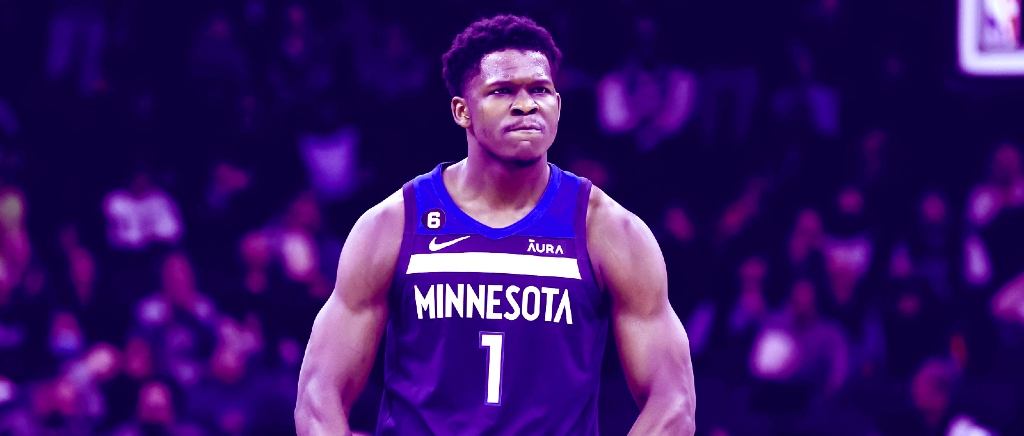
Through three Team USA exhibition games — wins over Puerto Rico, Slovenia, and Spain — Anthony Edwards’ numbers do not pop off the page. The All-Star wing is averaging 14 points (54.8 percent true shooting), 4.3 rebounds, two assists, and one turnover in 21 minutes per contest. Team USA has thus far elected for an egalitarian approach offensively, with Jalen Brunson and Tyrese Haliburton typically initiating the action. Edwards has rarely been compelled to assert himself, nor did the first two games ask him to do that, as they were blowouts.
Late in Sunday’s win, though, the newly minted 22-year-old strung together a handful of sequences that distanced his squad from the Spaniards, sparked nine points, and led the team to a third straight victory. Among those plays was Edwards turning defense to offense by winding around a pindown screen after a tardy start, rejecting a jumper, and cramming home a fast break slam.
Anthony Edwards gets over the pindown to block the three and then gets it in transition for the slam pic.twitter.com/5LKJ5RMrxS
— AlexHoops (@AlexHoops_) August 13, 2023
Despite the occasional hiccup — he could get lower in his stance on the ball, he’s prone to gambling, and his execution on switches remains dicey — Edwards’ defense has been a steadfast positive in these three international appearances. Whether that translates to FIBA World Cup play or the NBA’s regular season is a mystery, but Edwards has looked sharper, particularly with his off-ball awareness, motor, and impact.
Before entering the NBA, his understanding and investment in adhering to schemes off the ball lagged, along with his screen navigation. Because of his frame, quickness, and dexterity, he’s long projected as an overwhelming isolation defender, yet struggled wiggling over screens, which substantially narrowed his utility at the point-of-attack. Most encouraging from his summer showings up to this point is how well he’s performing in a chaser role. Mikal Bridges is usually assuming on-ball duties and that’s left Edwards to craft his signature elsewhere, weaving through pindowns and other off-ball screening actions.
He’s ducking his shoulder under picks to stay attached to assignments and wielding his strength and length to overwhelm opponents. Even if he’s caught on a pick or a tad late recognizing movement, he won’t give up on the play. His attention to detail and off-ball activity are persistent, something that’s predominantly ebbed and sometimes flowed in his career. He’s been a menace with his 6’9 wingspan to populate passing lanes, strip ball-handlers, and recover back into plays. In just 63 minutes, he’s tallied 10 steals and three rejections.
Part of Edwards’ defensive exploits are tied to his tantalizing physical tools. The athletic advantage he’s held on the international circuit is not as drastic on the NBA scene — he’s blotted out a few gaffes that would likely descend into full-fledged breakdowns in the league. Yet his willingness to remain engaged and generally dictate the terms of engagement are critical. Too frequently throughout his career, he’s banked on those tools being a magic bullet, only to be out of position for them to not matter. That’s rarely happening much in these exhibition games. He’s blending effort, technique, and athletic gifts, which would help turn an already impressive American defense into something even more troublesome for opponents.
At the point of attack, he’s played more erratically, though the instances of bouncy, enticing mobility to curb drives and prompt giveaways arise nonetheless. He’s pursuing tons of steals, sometimes to the detriment of a defensive shell, but is also rewarded fairly commonly to explain why he’s trying for so many pickpocketing possessions. That’s his style in the NBA, though, and it’s less fruitful. Sharpening the approach may behoove him long-term.
Anecdotally, his on-ball screen navigation hasn’t matched his off-ball endeavors, so translating some of these sequences to the NBA could also prove more challenging. It is, however, not difficult to watch him completely erase offensive intentions and ogle at his possibilities on the domestic stage. Crouch low, harass a live dribble, and gobble up space laterally. Edwards is doing precisely that on occasion, just as he’s exhibited in spurts with the Minnesota Timberwolves.
Given the lack of practice time and familiarity, Team USA’s offense has unsurprisingly been a bit sticky at times (cold outside shooting has also hurt). The playmaking aptitude of the roster is somewhat thin after Haliburton, too, though there are certainly talented distributors supplementing him. I just think the offense could shift into stagnant shot-making displays if Haliburton’s creation is quelled, although this group is capable of thriving that way.
Regardless, the defense, in part because of Edwards’ initial returns, might end up as the USA’s calling card. Fresh off his Defensive Player of the Year nod, Jaren Jackson Jr. is patrolling the interior like a hawkish hall monitor, whether it’s in ball screens, help rotations, or switching onto the perimeter. He’s been the team’s best player, complementing his domineering defense with efficient, selective scoring.
Together, he and Bridges form a sprawling pick-and-roll tandem. Jackson’s discipline, positioning, and timing as a drop defender are clinical, and Bridges is a nightmare when he tethers himself to initiators or walls off pocket passes around screens. I’ve loved watching them zap the gusto from offenses individually and collectively. I understand why the Memphis Grizzlies reportedly dangled four first-round picks to land Bridges and pair him with their All-Star big man this past winter.
Two more exhibitions await Edwards and USA before their World Cup debut against New Zealand on Aug. 26. Those represent a pair of chances to continue his upward ascent defensively. Behind playmaking and pacing refinements, he became a bona fide star last season. If he translates and maintains these defensive improvements into the fall, he’ll soon add “two-way” to that moniker, and everyone — himself, the Timberwolves, Team USA — will benefit.
